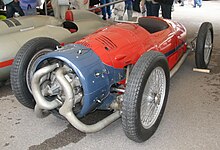Monaco-Trossi
The Monaco-Trossi was an Italian racing car from 1935, which was to start in the European Grand Prix Championship .
history
development
The engineer Augusto Monaco designed a monoposto for the 750 kg class with the support of Fiat founder Giovanni Agnelli . After Fiat ended the cooperation, Monaco was able to win the wealthy racing driver and Count Carlo Felice Trossi as a partner.
Monza 1935
The racing car drove from July 1935 for tests and to qualify for the XII. Italian Grand Prix at the Autodromo Nazionale Monza . Problems with the cooling of the engine and with destroyed spark plugs became apparent. Nevertheless, the Monaco-Trossi reached a promising 250 km / h.
The strong understeer due to the design could not be improved - the Monaco-Trossi was on the entry list for the start on September 8, 1935, but did not take part in the race. That ended the project.
Location of the vehicle
After the death of Carlo Felice Trossi in 1949, his widow, the Contessa Lisetta, donated the Monoposto to the Museo dell'Automobile in Turin .
construction
The air-cooled two-stroke - radial engine with 16 cylinders in two rows disposed in front of the front axle and drive to the front wheels. This ensured good cooling of the engine, a drive shaft to the rear wheels could be omitted and good traction of the front wheels was given by the front-heavy weight distribution.
Engine and drive
The eight pairs of cylinders were arranged in a star shape around the three-part crankshaft. In each of the two rows, eight pistons acted on a main connecting rod and seven secondary connecting rods. Each cylinder pair had a cylinder head that formed the common combustion chamber with only one spark plug for two pistons. The rear row of cylinders was charged by two Zoller M 160 compressors , each with a Zenith carburetor. Two exhaust manifolds in front of the engine led the exhaust gases to two long exhaust pipes on the side under the body to the rear axle.
Directly behind the engine was the manual four-speed gearbox with differential that drove the drive shafts to the front wheels. The clutch was located behind the gearbox towards the driver.
Structure and chassis
Manganese-molybdenum steel pipes from aircraft construction with a diameter of four centimeters formed the frame to which the light metal body parts were screwed. Double wishbones with horizontal coil springs guided the wheels; the oil shock absorbers could be adjusted from the cockpit. The driven front wheels with 5.25 × 31 tires were significantly larger than the rear wheels with 4.40 × 27 . The braking system consisted of four hydraulically operated drum brakes.
Web links
- Monaco Trossi: l'aereo senza ali. Nel 1935 un progetto bizzarro tenta l'avventura in F1. In: Retrospettive. OmniAuto.it, September 21, 2008, accessed June 18, 2019 (Italian).
Individual evidence
- ^ A b c William Pearce: Monaco Trossi 1935 Grand Prix Racer. William Pearce, September 1, 2012, accessed April 24, 2018 .
- ↑ Monaco - Trossi mod. because competizione. Museo dell'Automobile di Torino, accessed on April 24, 2018 .


